Euphorbia flower is one of the largest genera of the family of the same name. Plants related to it are very diverse in appearance. Among them there are small trees and shrubs, annual and perennial herbs, stem succulents. Common to all of them is the presence of milky juice in the tissues.
The name “euphorbia” was given to Euphorbia in honor of Euphorbus, who served as a court physician to the king of Mauritania in ancient times, and, according to legend, was the first to study and describe the medicinal properties of milky juice. Around the same time, spurge became a houseplant – it was grown with pleasure at home to be used for the preparation of medicinal potions.
Types of milkweed in the photo
The genus includes, according to various sources, from 800 to 2000 species, whose homeland is the tropical regions of Mexico. Many types of milkweed, photos of which are widely presented in our photo gallery, are also grown in room culture.
Euphorbia triangular, or triangular (Euphorbia triangularis, trigona) has three- or four-sided fleshy branching shoots of dark green color with a lighter pattern. On the edges grow small spines – leaves. This species resembles giant branching cacti and has one of the fastest growth rates, easily reaching the ceiling in a few years.
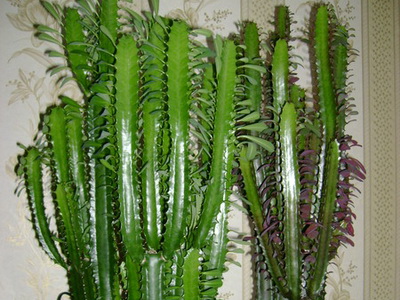
Euphorbia plump, or obese (Euphorbia obesa) is easily mistaken for a spherical cactus. It has a round, smooth, gray-green stem, divided into flat longitudinal ribs. There are no spines, but the main difference from cacti is the absence of areoles.

There are also quite original types, for example:
Euphorbia grandicornis (Euphorbia grandicornis) is a tree-like stem succulent with three-ribbed shoots, on which horn-shaped wavy-curved segments with paired spines are located.
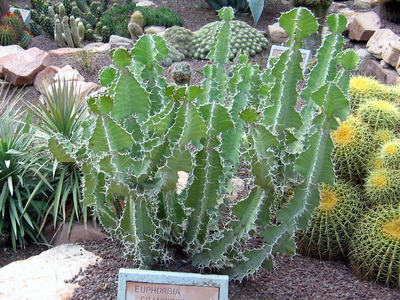
Or Euphorbia tirukali, or rubber-bearing (Euphorbia tirucalli) – a large shrub with a dense crown and forked-branched, pencil-like, leafless shoots.

Euphorbia brilliant, or Euphorbia Mil
Euphorbia brilliant, or Euphorbia Mil (Euphorbia splendens, milli) is a thorny shrub that grows up to 2 m in nature. The stems branch profusely and are covered with long dark purple spines, for which the people call this Euphorbia “crown of thorns”.
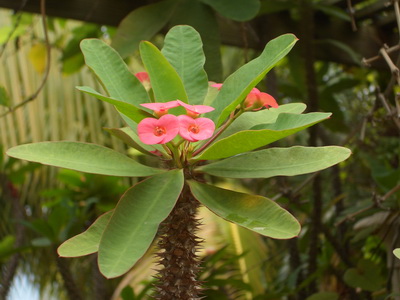
Euphorbia leaves are shiny oval, bright green, arranged alternately.
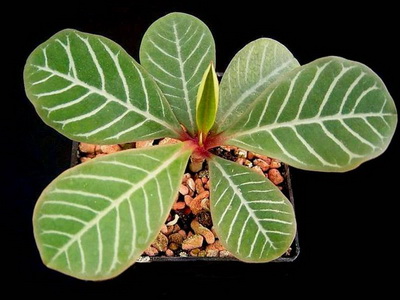
For the winter, shiny spurge can shed its leaves, new ones grow in about a month. In early spring, small yellow inflorescences, surrounded by bracts, open at the ends of the shoots. There are varieties with red, salmon and yellow covering leaves. Euphorbia Mil can bloom until mid-summer and even longer.
White-veined home spurge
White-veined spurge (Euphorbia leuconeura) is a stem succulent with a thick ribbed stem and large oval leaves with white veins.
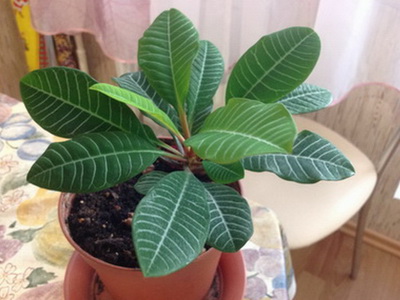
As it grows, the leaves at the bottom of the stem fall off, exposing it. For such a feature of growth, this species is often used as a “false palm”. The flowers are small, white-pink, inconspicuous. The resulting fruit-boxes are able to shoot “ripe seeds, as a result of which, after a while, a huge number of young seedlings of this plant appear in all the pots surrounding the indoor flowers.
Some species of domestic milkweed can be difficult to distinguish from cacti .
Care for indoor milkweed at home
Euphorbia like bright lighting all year round, are undemanding to the temperature regime, do not need to be sprayed. In the summer, these plants are very useful for a “vacation” in the open air, where they need to be protected from wind and rain, and you can shade a little, at first, from direct sunlight.
When caring for milkweed at home, it should be remembered that this is a moisture-loving plant: in summer it is watered abundantly, allowing the top layer of soil in the container to dry out between waterings. In winter, if the plant is in a cool room, at a temperature not lower than +1 0 ° C, it is rarely watered, if at room temperature, then moderately. Top dressing is carried out from spring to autumn twice a month with fertilizers for succulents.
Euphorbia is transplanted depending on the growth rate and age of the plant. All types of milkweed, except milkweed obese, reproduce well by apical cuttings. When preparing the cuttings, it is imperative to wash off the milky juice that stands out with warm water, dry the cut slightly and sprinkle it with crushed charcoal. After that, the prepared cutting is placed in the substrate for rooting. Euphorbia obese can only be propagated by seeds.
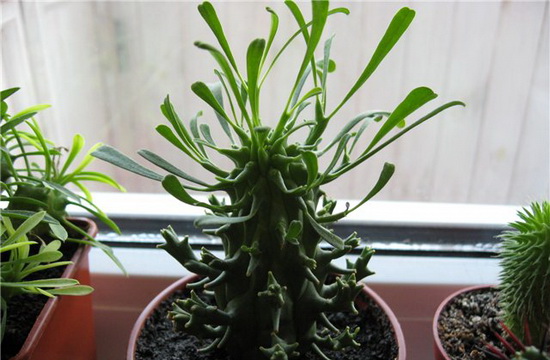
Euphorbia in the photo
Euphorbia (euphorbia) is an excellent plant for landscaping sunny southern window sills. It is not afraid of direct sunlight and does not need shading. Can be used both as tapeworms and in succulent compositions.
When working with indoor euphorbia, do not forget that the juice of these plants is poisonous . Do not place them in rooms where children and animals often visit!







